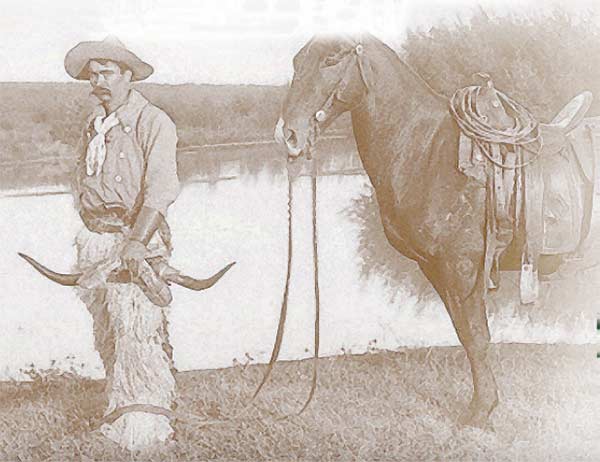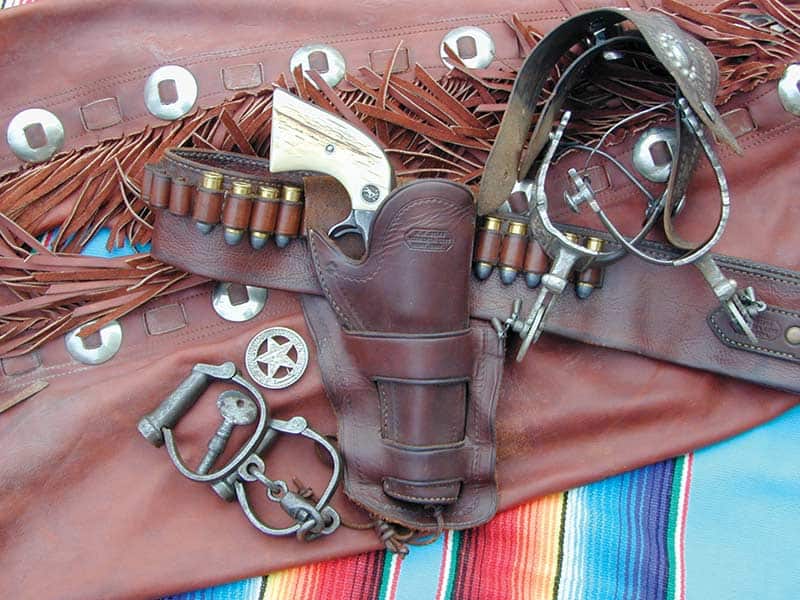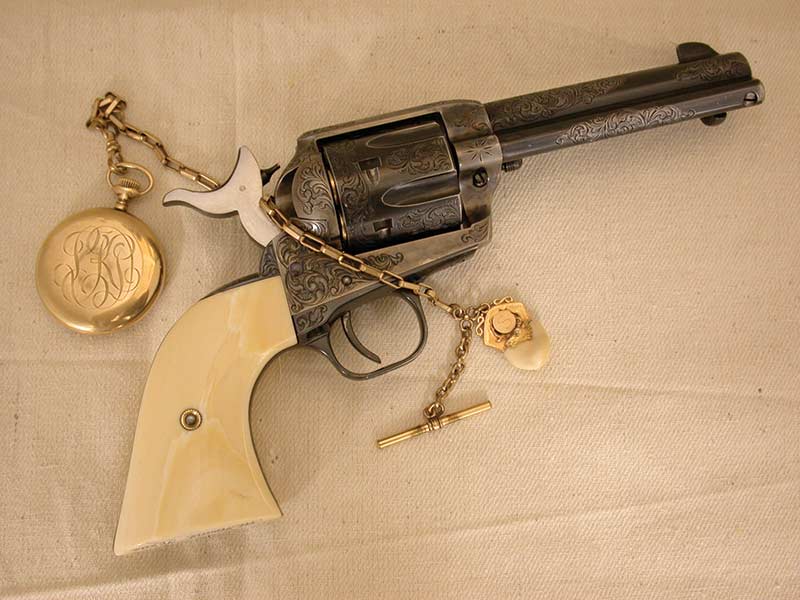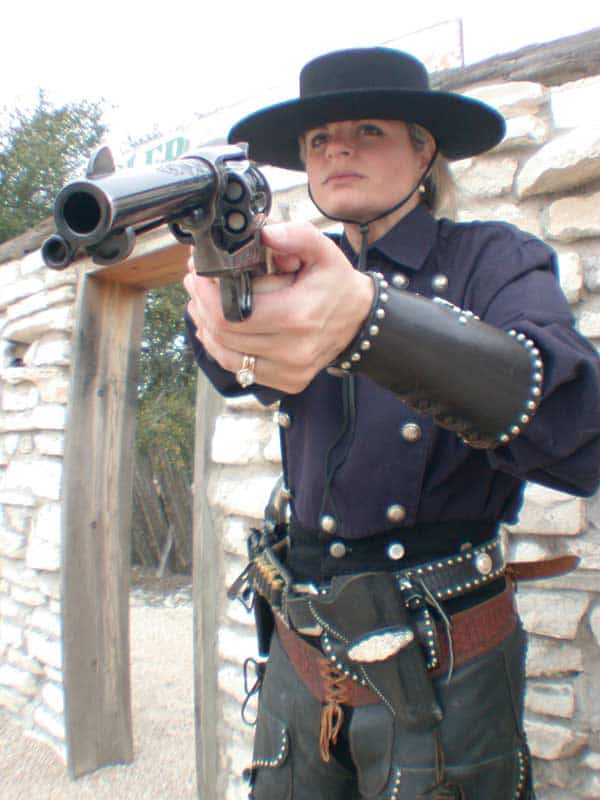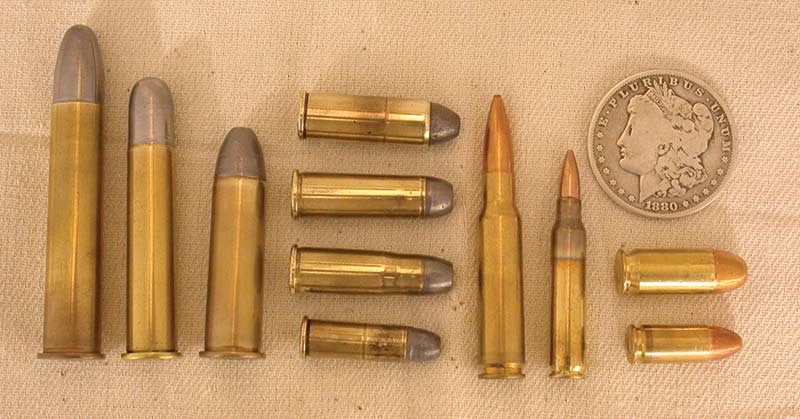Cowboy Action Shooting Then And Now
As the din of thundering horses’ hooves fills the darkened room, the tall man wearing the white hat draws the silver-plated Colt in a flash matched only by lightning. “Drop the gun,” our white-hatted friend declares to the mustachioed man in the black hat. There is a pause… “Watch out” clears your lips, but not to worry, the bad man’s draw and turn is slower than the chocolate slowpoke melting in your mouth.
A thumping boom fills the room. A growling sound emits from the bad man as he clutches his now empty gun hand. “We’re going to go see the Sheriff now and get this settled once and for all,” declares our hero.
As the doors swing open to the outside the sun blinds you, but it’s worth it. The story ended good for us — nobody got killed, the bad men are in jail and the singing cowboy got an icky smooch from the blonde haired girl. And — imagine the thought — we got through the whole movie without one bared breast or gory chainsaw massacre.
And there you have it, the silver-screen style of cowboy shooting, vintage 1957.
The Way It Really Was
In the real world, it wasn’t always so pleasant an ending. Many a long-standing feud boiled into gunplay. This one played out not once but three times before it was finally resolved permanently. On June 12, 1894, Pecos City Sheriff Bud Frazer drew down and shot Jim Miller. Three shots hit Miller, one in the right arm, one in the leg and the supposed fatal shot to the chest, which was in fact not lethal due to the fact Miller was wearing a steel breast plate which turned the projectile. Frazer did not “finish” Miller on that day, a fact he would later regret.
Round Two: While Frazer was visiting friends in Eddy, Texas, December 26, 1894, a second fight ensued and the now ex-Sheriff Frazer shot well, placing several shots in the chest area of his apparently bullet resistant opponent. Frazer had still not gotten the word that he was wearing out Miller’s shirt but not his bullet resistant plate.
All the appropriate people were contacted and the legal mumbo jumbo was discussed but to no avail. Miller swore out charges, Frazer responded and the jury acquitted Frazer thereby setting the stage for the final episode.
The final round: On the evening of September 14, 1896, the final chapter in the Miller — Frazer feud was settled. G.A. “Bud” Frazer sat down to his last game of cards in the local Toyah, Texas saloon. As he passed through the saloon door, and without any hesitation, Jim “Killer” Miller let fly with both barrels of a 12-gauge shotgun, removing the top part of Frazer’s head. The feud was over once and for all.
As you can tell from the description of these actual events, there was very little of the “high noon” challenge to come out into the street. There was the use of personal armor, shotguns and damn little personal chivalry. And then as now, handgun effectiveness was in question.
And there you have the real “cowboy way” circa the 1890s.
The Great American Myth
So what of the “cowboy way?” Of all the icons associated with the American way of life, the cowboy — the true cow-pushing cowman— maybe the most misrepresented. First off, in our country’s 220 plus years of existence, the true era of pushing cows across the country was a relatively short time frame, 30 or perhaps 40 years at the most if you stretch it.
In my last ten years living in south Texas I have heard and seen lots of people calling themselves cowboys, cowmen and cattlemen etc., while peering out of the GMC truck windshield. I don’t think so.
In reality, the true cowboy’s life was probably harder than a whore’s heart. The glitter as is shown by the Hollywood interpretation has very little to do with the way it really was. I’ve traveled by modern vehicle from south Texas to the Kansas cow town of Dodge City. Along the way I saw nothing that would lead me to believe the brush poppers of old just rounded up some long horn cattle and casually drove them over a thou-sand miles stopping at all the convenient Diary Queens along the way.
The moving of cattle was a hot, dirty and dangerous task. There was little to do but hard work, and this was followed by more of the same. Most often the cowpuncher’s rifles were carried in the chuck wagon to eliminate fouling when using ropes or while working cattle in thick brush. Simply put, the rifle butt was in the way.
Revolver holster designs of the era show a strong propensity for being deeply throated, which allowed the piece to be protected. They also commonly featured a tie down for the hammer spur to protect the revolver from being snatched while passing through brush or even worse yet, cocked while in the holster.
Because of mechanical design and application, it was in fact a wise idea to carry the hammer down on an empty chamber to prevent the revolver from discharging if it was lost from the holster or struck a blow on the hammer. Percussion revolvers could be staged so the hammer rested between two caps. The same could be done to the later metallic-cartridge revolvers but it often didn’t work as well. One was better served to lower the hammer on an empty chamber.
Many photos and written descriptions show the holster being worn far forward. This may have been staged for the photo, to show the folks back east “we are armed to the teeth.” Or it might have been for practical reasons, to keep the revolver from protruding from the puncher’s hip to reduce interference while working.
Itchy Trigger Fingers?
There would be no reason to think that the cowboys stopped of a night, drew their lead chuckers and blazed away practicing for some theoretical upcoming gunfight. One limiting factor is the damn cows would have stampeded to hell and gone, and then again I can think of nothing more dangerous than getting run over by a bunch of panicked cattle. Remember we’re speaking of an era without EMS or Life Flight helicopter. Let’s see… laying in a rocky, cactus covered flat owned by coyotes and buzzards with a compound facture to the leg. Sound like fun?
One has only to look at the surgical tools of the period to realize the wisdom of going to pretty much any end to avoid the prospect of being shot. But as it has been since the beginning of time, there is always some knot head who wants to scrap and just doesn’t fit into the “can’t we all just get along” mode. Hence the gunfight. Or probably more correctly called shootings in most of the incidents.
Surprisingly, most of the same elements common to gunplay of yesteryear continue to rear their ugly heads in contemporary “gunfrontations.”
More RealWorld Shootings
November 1, 1875, inside the St. James Hotel after “brief words” Clay Allison filled Pancho Griego with three rounds as the lights went out. Having been inside the St. James Hotel, the lighting issue was of interest to me. So shooting inside a representative closed area I found out a simple fact. Discharge a big-bore black powder revolver in a confined space and the concussion will blow the oil lamp lights out.
Gunfights in low or altered light. Hmm, sounds familiar. November 30, 1884, in Frisco, New Mexico the soon to be infamous self-appointed sheriff Elfego Baca becomes involved in a gunfight with local cowboys that leaves several dead. As an indication of the level of violence generated by this encounter, the door —just the door of the shack Baca took refuge in — had 367 bullet holes in it. Estimates range upwards of 4,000 rounds being expended in the melee. Sounds like a good place for a spare gun or ammunition or both.
February 8, 1887, outside the White Elephant saloon in downtown Fort Worth, Texas. Another lively discussion ends in gunfire between longhaired Jim Courtwright (declared by most to be the better shot of the two), and Luke Short.
Range to the targets can be determined by the fact Courtwright drew first and while attempting to shoot Short at muzzle contact distance, Courtwright’s hammer snagged on Short’s watch fob chain.
Courtwright’s pistol failed to fire first and he never caught up — the feisty Short then shot Courtwright three times. Fights are not always won by who draws first or shoots the fastest.
These are some documented historical examples of things that can still occur of a fashion today. And so there is no confusion, we were in fact talking about cowboys or cattlemen of the past and as you can see a lot of “slickers” while in town had lively discussions that were apparently harmful to your health. Even more so than stampeding cattle.
The cowmen of old did the come-along-little-doggie routine and when they a got to town were probably smart to drink some of the trail dust down, get a bath with soap and maybe visit the painted ladies. After that the wise ones took their money and went home. Some did, some did not — and some are also buried in scenic spots like Boot Hill, in Dodge City, Kansas.
So in reality most true cowpunchers were not gun wise in the Hollywood icon sense. Funny, the same seems to apply to today’s cowpunchers also.
Today’s Cowboys And Cowgirls
Without reservation cowboy action shooting as is promoted by the SASS or Single Action Shooting Society is very popular and grows more so daily. It is a fantasy-based shooting sport that allows men and women along with their families to dress in and be a part of the old American west.
After shooting for over 30 years I was a bit taken back a few years ago when I first started to participate in cowboy action shooting. Some of the gun handling and lack of muzzle control issues were startling. Some of these modern day pseudo-cowmen had an attitude that apparently possession of a sixgun or Winchester equated to competency. Of course this is not any truer today than it was for the cowpunchers of yesteryear.
Today, crossing over decades of time, modern shooters dress the part and participate in made up facades and scenarios depicting representations of gunfights and gunplay. Before the ever-present electronic timer these modern cowboys and cowgirls shoot their way in and out of troublesome saloons, corals, train robberies and such, having a grand time while peppering the steel bad guys.
Silly me, while shooting in the duelist category I thought it would be a good idea to practice sound fundamentals like using cover or going to representations of cover. After all it’s a make-believe train robbery, why can’t I use make-believe cover? Many a helpful old gun hand offered up suitable advice:
“If you’d quit movin’ o’er ta the darn doorway your time would be better… cause you ain’t too bad of a shot.”
Ahh yes, there is always that wily stop-watch.
So after a while, slow-witted jasper that I am, I figured it out. The game isn’t about shooting, it’s about how you dress! I have seen some gun handling I would advise against, but then I have to tell you they sure did have pretty looking clothes on.
It is in fact a social function — and a good one at that. It promotes safety with firearms (which is getting better all the time) and families shooting together with like-minded friends.
It is also increasing firearms ownership and awareness of firearms related issues. The persona and made up names are a great way for all involved to use their personal history or current occupational background to step out of the everyday world. “Ol’ Doc Bones” on Saturday may very well be the guy doing your hip replacement early Monday morning
Something In Common
In many respects the modern shootist has many things in common with the brush popper of the past. Both old and new, we don’t get to shoot as much we would like to or maybe need to. We’re both victims of having too little time and too little ammo. At least the brush poppers could shoot in any direction for practice — give or take a cowherd.
Today caution is advised because as my wife Heidi, a.k.a. “Emzy Ann Lakin” (her cowgirl name) says, “Every bullet that goes down the barrel can wind up having a lawyer attached to it.” In discussions with new shooters many mention that these cowboy guns are the only firearms they own. Some new folks have spent enough money on clothes and guns “they could ‘a burnt up a wet mule” with the pile of greenbacks they used.
I like the cowboy action people and I like their style of shooting. I have had some pretty interesting discussions with them and have seen some funny things though. At a local club in a recent administrative issue over dues or something foolish I heard a statement to the effect of: “Well I’ll just call him out and we’ll settle this once and for all.” I am sure it was all in good humor, but if it had turned into something else those comments might have had an interesting effect on the grand jury members.
I once cautioned a fellow for pointing a muzzle at me. “Don’t worry it ain’t loaded,” he spat back, “and besides it’s just a derringer.” I guess a .41 Remington wouldn’t kill me huh?
And yes, I am intrigued by all the guys and gals who won an End Of Trail or some such match who soon open shooting seminars. With the best line of all: “I guarantee I’ll make you a better shot.” Boy, after 30 years of teaching firearms I wish I could say that with the confidence they do.
Then As Now
In my opinion some points of interest should be brought up at this time. If you have a gun around the house, even a “cowboy” gun, you better know how to use it in a contemporary sense. These guns are viable defensive tools. Even the down-loaded, .38 Special, barely knock the paint off the plate guns used by some of the winners and shooting seminar instructors.
Next, personally I would not want to get shot — not even by a derringer. The guns used in cowboy action shooting are not toys. They will put a hole clean through the bad man, or any man, woman or child no matter the century. A full house load would probably serve the shooter best, black powder even better.
I wouldn’t fan or twirl the gun — I would count on using the sights at eye level, center on the target and shoot well if it was called for. If a .44 or .45 caliber revolver worked well for personal defense in 1883 or 1903, I’ll bet you it will work in 2003.
As a young man I had dinner with Janelle and Jeff Cooper of Gunsite fame many times, but one time sticks out as special to me because of the conversation. At that dinner Cooper revealed to me something I never really thought much about before. Since then I think of it often and being aware of it I see it played out more and more. His thought was, “most people will work harder to win a trophy than they will work to save their own life in a real fight.”
Those of us who shoot in cowboy action shooting should have our fun with the weekend gunfights, always remembering the true intent of firearms from the beginning of their existence. A firearm is for saving your life or the lives of your family. A firearm is also used to take the life of something we plan to eat. Everything after that — sporting clays, bullseye, ISU, IPSC, IPDA, SASS —is just for fun.
We should have our fun, but in doing so always remember why that truly unique American icon, the cowboy, carried his “smoke wagon,” and what his experiences can teach us today.

Get More Revolver Content Every Week!
Sign up for the Wheelgun Wednesday newsletter here:
